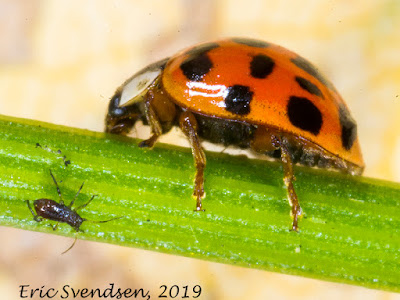The ant lion (doodlebug)
 |
| Ant lions - the insect version of sarlacc. |
Here, on present day Earth, there exists a similar malevolence. With jaws of spring steel and lightening fast reflexes, it waits silently at the bottom of a pit of its own. Tiny hairs peak up from its funnel-shaped base. Each one a trigger spelling doom for any visitors. This is the lair of the larval ant lion. Tiny in comparison to the sarlacc, but just as deadly, the insect hides beneath the substrate. Dinner is coming.
The trap itself is only an inch or two across. Very small ant lions produce traps with openings the size of a dime. Made out of sand, it awaits for something to approach. The step of an ant on the edge causes a single grain of sand to descent where it wakes the resident into action. Tossing sand up into the air with its great jaws, the ant lion is seeking to cause its meal to stumble. Once the prey slips and falls into the pit, panic sets in as it attempts to scurry away. More sand is flung, but the escape attempt is in vain as the desperate insect gets ever closer to the unseen awaiting jaws.
Then, a hair is touched, not by sand this time but by something larger. All its senses honed and tuned, the final act begins. Jaws as large as the ant itself open and are thrust out onto the awaiting meal. With no chance of reprieve, the ant lion snatches the ant and quickly draws it beneath the sand to await certain death.
I find these remarkable creatures in dry areas of the country where there are open sandy areas near ant colonies. Sunny paths which I travel on may be dotted with ant lion pits, each one hosting a ravenous hidden larva awaiting its next meal. I will take a fallen pine needle and touch the trap's side, watching the explosion of sand result from the stimulus. Occasionally, I will "volunteer" an ant and watch in morbid fascination as it attempts to escape the pit. Rarely successful, it falls further into the trap where it will meet its inevitable end.
It is amazing to see what other things ant lions prey upon. I have found moths' wings left behind; they will eat beetles and any other organism small enough to be overpowered. It may take two or three years for the growing larva to mature. When ready, they pupate and hide beneath the sand until they emerge as adults. They mate and the female deposits eggs in different sandy patches where the next generation can begin. It is amazing to see the beautiful adults, so different from their young. I can only image how an adult sarlacc may appear - it would certainly be something wonderful to behold.
Video on ant lions: https://www.youtube.com/watch?v=PaLILsssLYg



Comments
Post a Comment